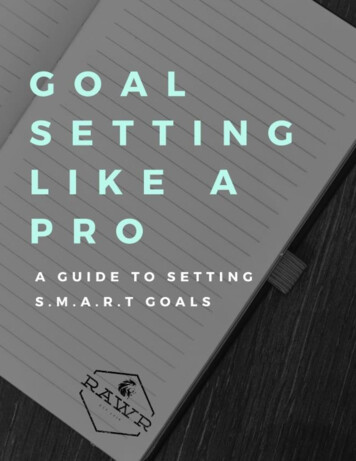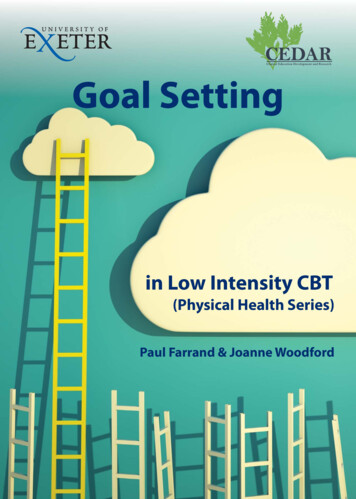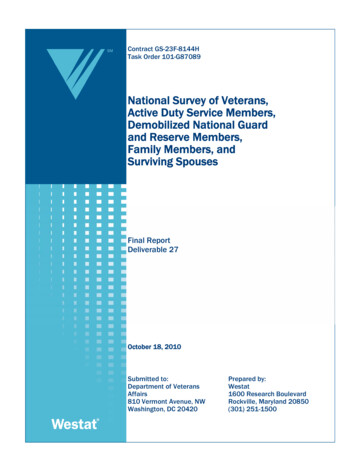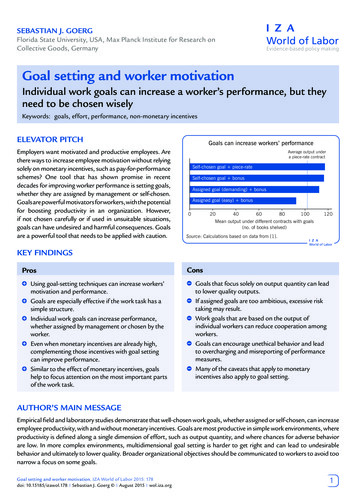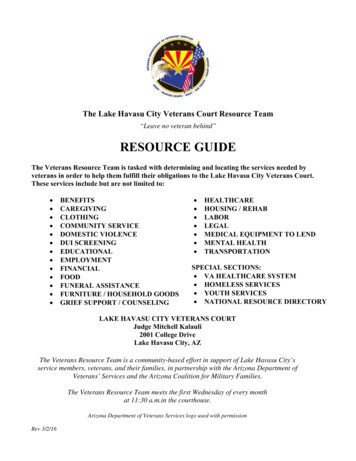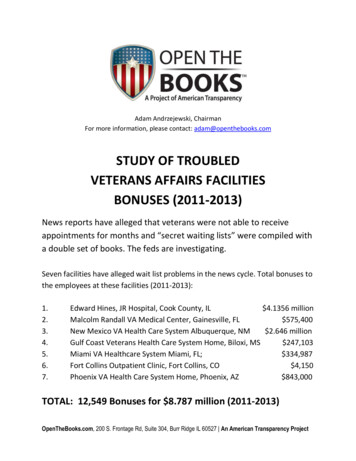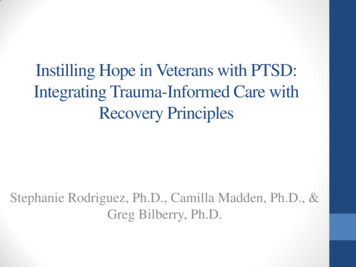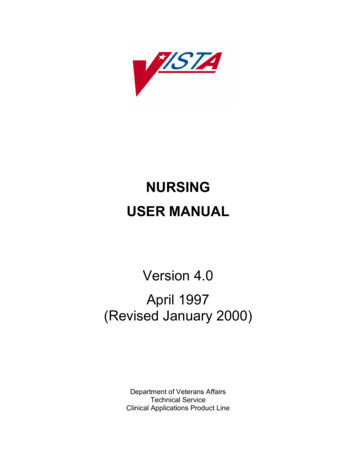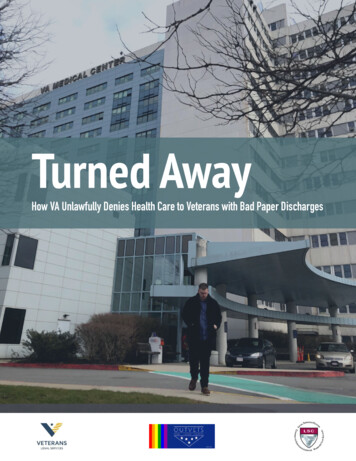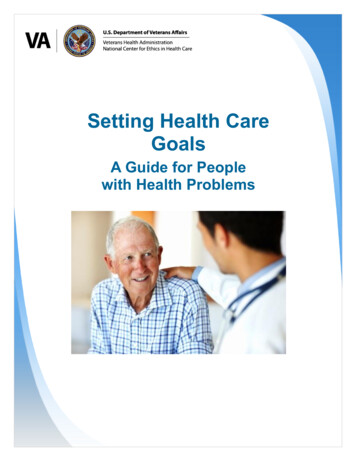
Transcription
Setting Health CareGoalsA Guide for Peoplewith Health Problems
National Center for Ethics in Health Care, Veterans Health Administration.Acknowledgements: Kenneth Berkowitz, Shaida Talebreza Brandon, Susan Crowley, JasonDominitz, Sharon Douglas, Jill Lowery, Ann O’Hare, Shirley Paski, Robert Pearlman, Virginia AshbySharpe, Steve Tokar, and members of the Life-Sustaining Treatment Advisory Boards of LovellFederal Health Care Center, VA Black Hills Health Care System, VA Salt Lake City Health CareSystem, and William S. Middleton Memorial Veterans Hospital.Updated: May 2018.
What is important to youas you think about the future?Different people want different things whenthey have serious health problems. Whatmatters to you should guide decisions aboutyour treatment. Talk with your health careteam about what is important and what youwant to accomplish. Your health care teamcan help you decide which treatments andservices would best help you reach yourhealth care goals.Ask yourself: What do I wantfrom my health care?You might want to Stay as independent as possible Cure an illness, or improve the qualityof your life when cure is not possible Prolong your life Get support for loved ones orcaregivers Feel well enough to attend a specialevent, like a wedding or a trip Ease symptoms so you feel morecomfortable Get support to stay at homeWhat should I talk about withmy health care team? Your medical condition – what it isand how it might change What is important to you – in yourlife, and about your health care Your health care goals – what youwant your health care to help youaccomplish or avoid Which services and treatmentswould likely help you reach yourgoals and be acceptable to you Support you might want – physical,emotional, spiritual Your health care surrogate – theperson you want to communicateyour decisions if you become toosick to speak for yourself1
Who should be part of theconversation with my health careteam?What can I do to get ready for aconversation about my healthcare goals? Your health care surrogate – theperson you want to communicateyour decisions if you become toosick to speak for yourself Family members or others you trustwho support you 2Think about what is important toyouThink about the results you wantfrom your health careInvite your health care surrogateand other people you trust to bewith you during the discussionBring your advance directive, if youhave one, when you meet with yourhealth care provider or team
A message for people whose loved oneis too sick to communicate theirown health care decisionsWhen a person is too sick to make decisions, the health care team relies onsomeone close to that person to help them understand what the person wouldwant. If you are responsible for communicating health care decisions for someoneelse, your job is to tell the health care team what that person would say about theirgoals and the type of care they would accept. Their health care should match thatperson’s values, beliefs, and preferences. If you don’t know what those are, youshould make decisions that are in that person’s best interests.How do I know what the person who is ill would decide?Think about what you know about them. What would they say is important to themnow? What did they say about other people who were in similar situations? What didthey say they would want, or would want to avoid? They might have completed anadvance directive or life-sustaining treatment plan sometime in the past. Thosedocuments can help you understand what their goals and preferences would be now.Communicating health care decisions for others, even when you know what theywant, can be stressful. The health care team can help you by providing informationand support.3
Information AboutLife-Sustaining TreatmentsWhat are life-sustaining treatments?Life-sustaining treatments might help you live longer whenyou would be expected to die soon. Examples of thesetreatments are feeding tubes, mechanical ventilation,dialysis, and cardiopulmonary resuscitation (CPR).Life-sustaining treatments might or might not work to helpyou live longer. Whether they are likely to work depends onyour medical problems. They do not cure disease or chronicillness. Sometimes they are used for a short time to get aperson through a health crisis, like when a chronic illnesssuddenly gets worse or while a person is being treated for asudden serious illness. They can help some people withcertain medical conditions live for a long time. Sometimesthey cause complications or discomfort.Decisions about life-sustaining treatmentsSome people would want life-sustaining treatments, and others would not.Some people would want some life-sustaining treatments but not others.Decisions about life-sustaining treatments should be made based on your goalsand your preferences.Your health care team can give you more information aboutlife-sustaining treatments. Talk with them about how thesetreatments relate to your condition and your health care goals.4
Information for Patients and Families AboutFeeding TubesWhat is a feeding tube?A feeding tube carries liquid nutrition, fluids, and medications directly into yourstomach or intestines.One kind of feeding tube goes into the nose, down through the throat, and intothe stomach. It is about one-eighth of an inch in diameter.Another kind of feeding tube goes through your skin into your stomach orintestines. Putting in the tube requires a minor procedure or surgery.When might a feeding tube be considered?A feeding tube might be considered if you: Can’t eat enough to meet your body’s need for nutrition Can’t eat safely due to swallowing problemsThese problems might happen if you are very sick, have brain damage, or havehealth problems that affects your nerves and muscles. If you are expected torecover the ability to eat and swallow, a feeding tube might be considered for ashort time. If you are not expected to recover the ability to eat and swallow, apermanent feeding tube might be considered.Sometimes people who have trouble eating on their own (for example, someonewith dementia or muscle weakness) can get more nutrition when someone helpsfeed them. In those cases, a feeding tube might not be needed.If you have a severe illness that cannot be cured and gets worse over time, gettingweaker and not being able to eat enough on your own can be a sign that you aregetting closer to dying. Some diseases, in the very late stages, cause your organsto stop processing food and water normally. In those cases, a feeding tube mightnot help you feel better or live longer.Feeding Tubes5
Benefits and RisksWhat are some possible benefits of a feeding tube?Depending on your condition, a feeding tube might prolong your life.When your swallowing problem is expected to get better, having a feeding tube for ashort time can help improve your nutrition. For example, a short-term feeding tubemight help if you are recovering from a surgery or receiving a treatment that makesyour throat very sore.Long-term feeding tubes can help if your swallowing problem is caused by damage toyour nerves or muscles.You do not need to be in a hospital to receive fluid and nutrition through a feeding tube.With some swallowing problems, there is a danger that food or fluids could go “downthe wrong pipe” and go into your lungs. It is not clear that feeding tubes help reducethis risk.What are some possible risks of a feeding tube?Feeding tubes can cause bleeding, infection, skin irritation, leaking around the tube,nausea, vomiting, and diarrhea.The tube can get blocked or fall out, and need to be replaced in a hospital.You might find the tube to be uncomfortable.You might inhale fluid into your lungs with a feeding tube. This could cause pneumonia.Depending on your condition, the feeding tube may not help you feel better, gainweight, become stronger, or live longer. There is no evidence that feeding tubes helppeople live longer when they are in the last stages of a severe and incurable illness suchas dementia or cancer.Feeding Tubes6
What to ExpectWhat if I have trouble eating or swallowing and I have afeeding tube?If you are awake and aware of what’s going on, having a tube down yournose and throat can be somewhat uncomfortable. It is usually notpainful, and many people get used to it over time.Having a tube that is placed through your stomach wall is not usuallypainful, and you can hide it under your clothes.It is harder to get around when liquid is flowing through the feedingtube.If you get confused, you might pull on the feeding tube. To prevent thisfrom happening, you might be given medication to make you sleepy, youmight have cloth wrapped around your mid-section to keep the tube inplace, or you might have your hands covered or restrained.You would receive care to help you be as comfortable as possible.Feeding Tubes7
What to ExpectWhat if I have trouble eating or swallowing and I do not havea feeding tube?Sometimes people who have trouble eating enough on their own canget more nutrition when someone helps them eat. You might continueto take in your favorite food and drinks, with help if needed, as long asyou wanted to eat and were able to do so.You would receive care to help you be as comfortable as possible.Without fluids or nutrition at all, some people might feel hungry orthirsty at first and others may not. You might be given ice chips andmouth swabs to keep your lips moist. The amount of time a person cansurvive without food depends on their health, body weight, and whetheror not they are taking in fluids. Some people who are not eating at allbut are taking sips of water have been known to live up to 20-40 days.Some people who are eating small amounts and drinking fluids mightlive for years. Without any fluid, people might die within days to weeks.In the last stages of severe, incurable illness, when death is near and aperson is no longer taking in food or water by mouth, families oftenworry that the person will “starve to death.” In fact, for people withthose medical problems, no longer taking in food and water is a natural,non-painful part of the dying process. In this case, the person is notdying because they have stopped eating, rather they have stoppedeating because they are in the dying process.You would receive care to help you be as comfortable as possible.Your health care team can tell you if you are at risk for problemswith eating or swallowing. Talk with them about treatment optionsthat will support your goals and preferences.Feeding Tubes8
Information for Patients and Families AboutDialysisWhat is dialysis?Dialysis filters a person's blood to remove waste products when their kidneys can nolonger do the job. Dialysis is a type of life-sustaining treatment.There are two main types of long-term dialysis.Hemodialysis is the more common type of dialysis. In hemodialysis, your blood flowsHemodialysisis themoretocommondialysis. Inthrough a tube outside ofyour body intoa filterremove typewasteofproducts.A needle isbloodflowsarm.througha tube isoutsideof to ainserted into one of thehemodialysis,blood vessels,yourusuallyin yourThe needleattachedyourbodyinto blooda filterintoto removewasteneedletube that carries a steadyflowof yourthe filter.Afterproducts.the bloodA isfiltered ofis insertedinto oneof thea bloodin your intowaste products, it returnsto your bodythroughsecondvessels,needleusuallythat is insertedarm. sessionThe needleattacheda tubecarriesa steadyat leastanother blood vessel. Eachlastsisaboutfourtohoursandthatmustbe repeatedthree times a week. flow of your blood into the filter. After the blood is filteredof waste products, it returns to your body through a secondIn peritoneal dialysis, yourbloodis iscleanedwhenproductspass outEachof the bloodneedlethatinsertedintowasteanotherblood vessel.vessels of your intestinesinto cleanthatis hoursflushedandin andyour peatedat leastfluid from a bag flows througha tubethat goes through the skin of your belly into athree timesa week.space inside, around your intestines. The fluid stays there for several hours, and wasteproducts from the blood pass into it. The fluid containing waste products then drainsIn peritoneal dialysis, your blood is cleaned when wasteout through the tube and is thrown away. This process is repeated several times a day,products pass out of the blood vessels of your intestines intoor each night while you are sleeping.clean fluid that is flushed in and out of your belly. Clean fluidfrom a bag flows through a tube that goes through the skin ofyour belly into a space inside, around your intestines. Thefluid stays there for several hours, and waste products fromthe blood pass into it. The fluid containing waste productsthen drains out through the tube and is thrown away. Thisprocess is repeated several times a day, or each night whileyou are sleeping.Dialysis9
When Might Dialysis Be Considered?In many people with long-standing kidney disease, the problems slowlyget worse over time. Dialysis would be considered when your kidneys canno longer remove enough waste products from the blood to keep youfeeling well, and a kidney transplant is not available. You might feel sick toyour stomach, tired, and weak. You could have little appetite and mighthave swelling. It might be hard to breathe or think clearly. Dialysis mighthelp to partly relieve these symptoms.Kidney problems may also come on quickly. If a severe illness causes thekidneys to fail or suddenly get worse, dialysis might be considered to helpclean the blood during that time. Sometimes the kidneys start workingagain after the severe illness has passed. Other times, the kidneys don’tstart working normally again, and long-term dialysis may be needed afterthe severe illness has passed. The kidneys are more likely to beginworking again if the person's overall recovery from the sudden illness isgood.Dialysis10
Benefits and RisksWhat are some possible benefits of dialysis?Dialysis may prolong your life, depending on your other health problems.Dialysis may help you feel better. You may feel less sick to your stomach, tired, orweak. You may have less swelling. Your appetite may get better. You may havefewer problems breathing or thinking clearly.Unless you have other health problems that would prevent you from being active,you might be able to go back to work and participate in activities that you enjoy.If you are eligible for a kidney transplant, dialysis can keep you alive while youwait for a donor.What are some possible risks of dialysis?You may feel dizzy, tired, or have cramping after dialysis.Access to your blood vessels (for hemodialysis) or the tube into your abdomen(for peritoneal dialysis) may get blocked. This can cause discomfort, and youmay need a procedure to fix the problem.You may be more likely to get infections, and suffer from heart disease andother medical problems. As a result, you may need to come into the hospitalmore often and stay longer. These problems can also increase the risk ofdeath.For people with some medical problems, dialysis does not help them livelonger or feel better.Dialysis11
What to ExpectWhat if my kidneys fail and I have dialysis?You may choose dialysis when your kidneys can no longer remove enoughwaste products from the blood to keep you feeling well.If your kidneys fail quickly, a tube will be placed into one of your blood vessels.The tube carries a steady flow of your blood through a filter to clean it. Thismay be done daily or as needed until your kidneys get better. If your kidneysdo not get better, you and your health care team will discuss whether longterm dialysis will help.For long-term dialysis, you would need surgery to prepare the blood vessels inyour arms (for hemodialysis), or surgery to have a tube placed into your belly(for peritoneal dialysis).Most people receive long-term hemodialysis in a hospital or in a dialysis center,usually three times each week. You may be able to have hemodialysis at homeif you have a trained helper. During each hemodialysis session, you would sitnext to a machine that removes waste products from your blood. Each sessionlasts about four hours.Peritoneal dialysis is usually given at home, and may also be given while aperson is at work or traveling away from home. To have peritoneal dialysis, youmust be able to do it yourself or have someone who can help you. Peritonealdialysis is repeated several times a day, or each night while you are sleeping.Dialysis12
What to ExpectMore about what to expect with dialysis If you receive dialysis, you would have to be careful about the types of food youeat. You would need to limit the amount of salt and certain other foods thatyou eat, and how much water you drink.Medicines may be needed to control blood pressure, treat anemia, and preventbone and heart disease.You would have to adjust your schedule to allow time for dialysis.Dialysis is not as good as healthy kidneys at filtering your blood. As a result, youmay not feel well.Most people receiving long-term dialysis have a shorter than normal life span.Dialysis13
What to ExpectWhat if my kidneys fail and I do not have dialysis?Most people can live for some time with kidneys that are only partly working. Whenthe kidneys are not working properly, waste products slowly build up in thebloodstream. This might make you feel sick to your stomach, tired, and weak. Youmight have little appetite and have swelling. You would receive care to help you beas comfortable as possible.When a person’s kidneys become very weak, death may occur within days to weeks.Death from kidney failure usually involves feeling less and less awake and may resulteventually in coma. You would be given treatments to manage discomfort frompain or fluid build-up to help you be comfortable.Your health care team can tell you if you are at risk forkidney failure. Talk with them about treatment optionsthat support your goals and preferences.Dialysis14
Information for Patients and Families AboutMechanicalVentilationWhat is mechanical ventilation?Mechanical ventilation helps you breathe when you can't breathe on your own.It doesn't fix the problem that causes you to have trouble breathing. Being ableto breathe on your own again depends on whether the problem that causesyour breathing trouble improves.There are two types of mechanical ventilation.Non-invasive mechanical ventilation helps you breathe bypushing air through a mask that is placed over your nose andmouth. Straps keep the mask in place. A machine pushes airand oxygen through the mask, and the pressure of the air helpsyou breathe. One type of non-invasive mechanical ventilationis called CPAP (continuous positive airway pressure) andanother is called BiPAP (bi-level positive airway pressure).Invasive mechanical ventilation uses a machine to push air andoxygen into your lungs through a tube in your windpipe. Themachine is often called a ventilator. The tube goes throughyour mouth or nose, or through an opening that has been madein your throat, through your windpipe to your lungs. The tube isabout as big around as a dime.Mechanical Ventilation15
When Might MechanicalVentilation Be Considered?CPAP or BiPAP might be considered if you needsome help breathing.A ventilator might be considered if yourbreathing problems are more severe. Aventilator is used to breathe for you when youcan’t breathe on your own.Mechanical ventilation might be considered ifyou have: New or long-term severe lung problemsBrain damageAn injury to your spinal cordSevere weakness of the muscles in yourchestYou might need mechanical ventilation for a fewhours, a few days, or the rest of your life,depending on your condition. At first, it might behard to predict how long you would need it.Mechanical Ventilation16
Benefits and RisksWhat are some possible benefits of CPAP, BiPAP, and a ventilator?They might make it easier for you to breathe.They might help you breathe while you recover from a serious illness.They might prolong your life, depending on your condition. People with someconditions live for years using mechanical ventilation.What are some possible risks of CPAP and BiPAP?You may have a dry nose and sore throat. You may have arunny nose, congestion, and sneezing. You may getnosebleeds.It may irritate your eyes and the skin on your face.You may have abdominal bloating that causes discomfortor nausea.There isriskssomeofincreasedrisk of lung infections and sinusWhat are some possiblea ventilator?infections.A ventilator places a person at high risk for infections.You might find a ventilator to be uncomfortable. You might try to pull the tube. Toprevent this from happening, you might be given medicine to make you sleepy oryour hands might be restrained.Some people who need a ventilator do not recover to be as healthy as before.You would need a lot of help. Most people on a ventilator need to be monitored inan intensive care unit or similar setting. Some people can be cared for in a nursinghome or in their own home if they have care from professionals with the propertraining.Mechanical Ventilation17
What to ExpectWhat if my breathing problems get worse and I use CPAP or BiPap?You would wear a mask over your nose, or over both your nose and mouth.Straps would keep the mask in place. The mask would be connected to a tubeand a small machine that would push air into the mask.You could remove the mask if needed.You would be able to eat and talk.What if my breathing problems get worse and I do not use CPAP orBiPAP?If you choose not to use CPAP or BiPAP, you would receive care to keep you ascomfortable as possible. You would be offered medications to help you relax sothat you do not feel like you have to struggle for breath or feel any discomfort.Mechanical Ventilation18
What to ExpectWhat if my breathing problems become severe and I use aventilator?A tube would be placed in your windpipe through your nose or mouth andconnected to the ventilator. The ventilator would push air through the tubeinto your lungs. You would receive care to keep you as comfortable aspossible.You might find a ventilator to be uncomfortable. You might need to takemedication to make you sleepy, or have your hands restrained if you try topull on the tube.If you need the ventilator for more than about two weeks, you would need ashort surgery to place a hole in your neck where the breathing tube would beplaced in your windpipe. This hole in your neck is called a tracheostomy.You generally cannot talk, eat or drink while on a ventilator, and nutritionwould be provided through a feeding tube. In some cases, people who are ona ventilator for a long time can be fitted with tubes to allow them to eat andspeak.Some people who are on a ventilator for a long time can get around in aspecial wheelchair.If you need a ventilator for a long time, you might be able to go to a nursinghome or your own home if you have professional care to monitor andmaintain the ventilator.Mechanical Ventilation19
What to ExpectWhat if my breathing problems become severe and I do not usea ventilator?You would receive care to keep you as comfortable as possible. You wouldbe given medicines to help you relax or sleep. This would help you feelcomfortable and not feel like you have to struggle for breath.If your lungs fail completely and you have decided not to use a ventilator,you would probably die within minutes or hours.If you are on a ventilator and decide to stop, you might die within minutes,although you might live for several hours. Sometimes a personunexpectedly survives for several days or even longer.Your health care team can tell you if you are at risk forserious breathing problems. Talk with them abouttreatment options that support your goals and preferences.Mechanical Ventilation20
Information forPatients and FamiliesAboutCPRWhat is CPR?CPR stands for cardiopulmonary resuscitation. It is sometimes used in anemergency when someone’s heart has stopped beating adequately. Cardiacarrest is another term for when the heart stops beating.If you are in cardiac arrest, blood stops flowing through your body.This means that oxygen cannot get to your brain or other organs. Your brain cansurvive without oxygen for only about five minutes. After that point, you wouldhave permanent brain damage, even if your heart started again.CPR can help blood and oxygen flow in your body while medical staff try to getyour heart to beat normally again. This may help prevent brain damage.CPR may include: Someone pushing on your chest with their hands (chest compressions) Someone giving you medications to stimulate your heart A machine giving you one or more quick electrical shocks to your chest(defibrillation) Someone pushing air into your lungs, either from their mouth into yours(mouth-to-mouth), or using a small bag attached to a mask. Someone mayput a tube down your throat to open your airway if air is not reaching yourlungs without it.CPR21
When might CPR be used?You would only get CPR if your heart stopped beating (cardiac arrest). Cardiacarrest can be expected or unexpected. It is a normal part of the dying process.Cardiac arrest could happen unexpectedly because of a sudden severe illnessor injury, or due to a heart problem that the person may or may not knowabout.Health care staff would automatically do CPR if you went into cardiac arrest,unless you have a Do Not Attempt Resuscitation (DNAR) order. A DNAR ordertells health care staff not to do CPR if you go into cardiac arrest. In someplaces, this order is called a Do Not Resuscitate (DNR) order.You have a choice about whether or not you would get CPR when your heartstops beating. Your choice about CPR does not affect the care you will receiveor your decisions about other treatments.CPR22
Benefits and RisksWhat are some possible benefits of CPR?CPR can save lives, especially when given to a young, relatively healthyperson right after their heart stops. After CPR, some people return toabout the same health they were in before their heart stopped. This ismore likely if the person does not have serious health problems, and ifCPR is started quickly after their heart stops.CPR might or might not work to re-start your heart. It is more likely towork if you are relatively healthy before a cardiac arrest. The chances ofsurviving are a little better if CPR is started quickly after the heart stopsand if you receive CPR in the hospital. About 18 out of 100 people whoget CPR while in the hospital survive their hospital stay, and about 82 outof 100 people die. Survival chances for you may be more or less,depending on your health problems.What are some possible risks of CPR?CPR often does not work to re-start the heart, especially when given tosomeone who has more than one illness or a very serious disease.If you survive after CPR, you may have a sore chest or broken ribs becauseof the chest compressions. You may have a collapsed lung. If your heartre-starts after CPR but you do not start breathing on your own, you wouldneed a breathing machine (ventilator) to help you breathe.If you do not get enough blood to your vital organs during cardiac arrestand you survive after CPR, you might have serious problems afterward.You might have brain damage or be dependent on others to care for you.CPR23
What to ExpectWhat if my heart stops?If you have a cardiac arrest, you would lose consciousness and pass outquickly. Once you passed out, you would not feel anything.If you do not receive CPR, or if CPR does not work to restart your heart,you would die. If CPR works to restart your heart but you do not startbreathing on your own, you would be put on a breathing machine(ventilator), unless you have a doctor’s order stating that you do not wantto be on a breathing machine. If CPR works to restart your heart, youwould receive medical care to treat any problems caused by CPR. Somepossible risks of CPR are listed on the page before.Your health care team can tell you if you are at increased risk forcardiopulmonary arrest. Talk with them about treatment optionsthat support your goals and preferences.CPR24
Tell Us What Matters to YouTalk with people you trust and with your health care team aboutwhat is important to you, and what you want to accomplishthrough your health care. Based on your priorities, your healthcare team can help you decide which services and treatmentswould – and would not – be likely to help you reach your goals.OUR COMMITMENTUnderstanding whatis important to youand providing healthcare that helps youreach your goals
Depending on your condition, the feeding tube may not help you feel better, gain weight, become stronger, or live longer. There is no evidence that feeding tubes help people live longer when they are in the last stage
